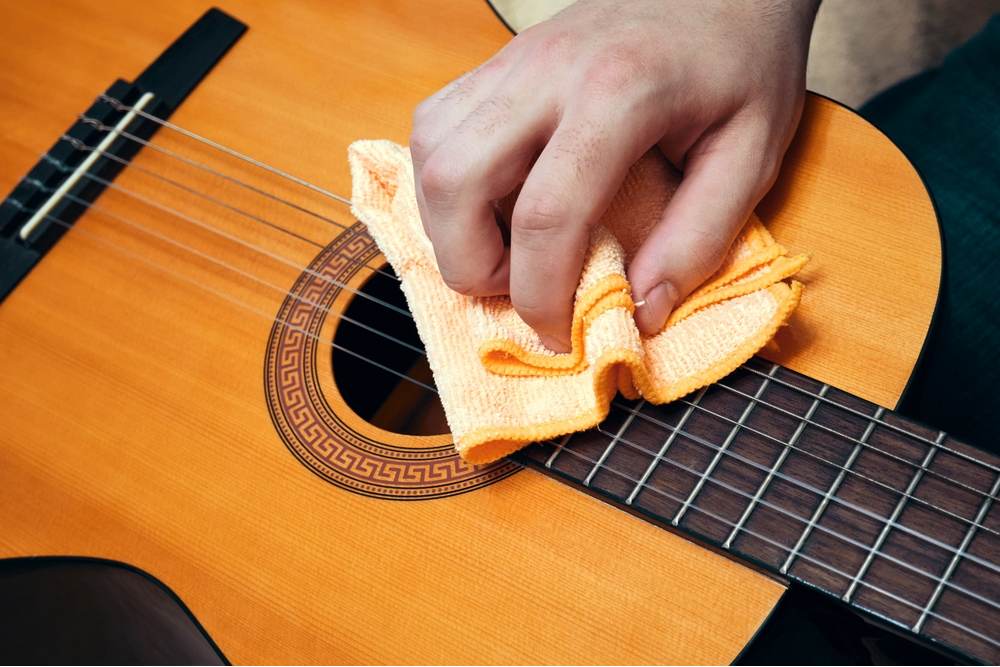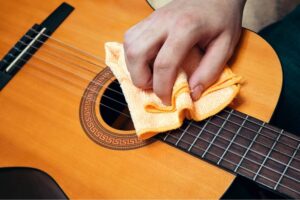
Proper bass guitar maintenance is essential to keeping your instrument in good condition and making sure it performs at its best. Beginners can and should learn how to properly clean their own bass guitar. Regularly cleaning your bass guitar can help prevent a buildup of dirt, sweat, and other gunk that can affect the sound and playability of your instrument. You might be surprised to learn that cleaning a bass guitar isn’t that difficult and can even be done with simple items found around your home. Here’s everything you need to know about proper bass guitar maintenance to keep your instrument in good condition, improve the sound quality, and ensure that it will last for many years to come.
Important Parts of the Bass Guitar
Before you begin cleaning your bass guitar, it is important to learn about the different parts of the instrument so you can better understand how to clean and maintain each one. These are the important parts of the bass guitar that you will need to know about when performing maintenance on your instrument:
Body
The body refers to the main part of the bass guitar, which can come in various shapes and sizes. The typical body of a bass guitar is made of wood and is where the sound gets produced.
Neck
The neck is the long, thin part of the guitar where you press down on the strings and create different notes and sounds.
Headstock
At the top of the neck is the headstock, which holds the tuning machines for the bass guitar. The headstock serves as the anchor point between the neck and string positioning.
Tuners
The tuners, or tuning pegs, are what you use to adjust the tension and pitch on the strings.
Nut
The nut is a small piece at the top of the neck that holds the bass guitar strings in place, maintains their spacing over the fretboard, and guides them to the tuning pegs.
Fretboard
The fretboard is the flat, typically wooden surface of the neck of the bass guitar that holds the frets.
Frets
Frets are thin metal bars along the fretboard that divide the neck into different notes.
Pickups
Pickups are electronic components of a bass guitar that detect the vibrations of strings and convert those into an electrical signal. Pickups are typically located near the bottom of the neck or in the middle of the body.
Bridge
The bridge refers to the component at the opposite end of the headstock that anchors the strings to the body. The bridge also holds the strings at the proper height above the fretboard.
Saddles
Saddles are small metal components that the bass guitar strings rest on as they pass over the bridge.
Output Jack
The output jack is the port on the body of the guitar where the cable plus in to connect the instrument to an amplifier or other sound system.
What You’ll Need to Clean a Bass Guitar
Most items you will need to clean a bass guitar can be found around the home or at your local music store. The most important items for cleaning your bass guitar include soft, lint-free cloths, microfiber cloths, mild dish soap, guitar polish, and warm water. You can make your own cleaning solution by combining a few drops of mild dish soap with warm water, or you can purchase a cleaning agent approved for use on bass guitars. Always wash your hands before you get started cleaning your bass guitar to make sure you remove all excess dirt and oils that can negatively impact the cleaning process.
Step-by-Step Guide to Cleaning Your Bass Guitar

Gather your necessary materials and follow this step-by-step guide to properly clean your bass guitar.
Remove Guitar Strings
The first thing you should do when preparing your bass guitar for maintenance is to remove the guitar strings. Removing the guitar strings makes it easier to access and clean all the various parts of the instrument. First, you will loosen the string tension by turning each tuning peg counterclockwise. Then unwind the string from the tuning peg gently to avoid tangling or damaging them. Once you unwind the string from the tuning peg, you can then remove the string from the bridge by gently sliding it out of the saddle slot.
Clean Guitar Strings
You can use a soft cloth or a specialized cleaner for guitar strings to remove the buildup of dirt, sweat, and oils on the guitar strings. Wipe each string individually with a dry cloth to remove dirt and grime, and always use a clean cloth for each string. Then you can apply a mild cleaning solution or string cleaner specifically designed for bass guitar strings to each string individually. Always wipe away any excess cleaner with a clean, dry cloth to help prevent any unnecessary buildup.
Clean the Headstock
Wipe down the headstock with a clean, dry cloth to remove any obvious signs of dirt, grime, or fingerprints. Then apply the appropriate cleaner to the cloth and gently rub it on the headstock. You should avoid getting any cleaner on any of the hardware and follow your manufacturer’s instructions for your specific bass guitar. You may also need a small item like a brush or cotton swab to get at hard-to-reach areas around the tuning pegs. Next, wipe away any excess cleaner with a clean, dry cloth.
Clean the Neck
The neck and fretboard accumulate dirt, oils, and grime over time, so this area will need to be cleaned next. It is important to note that the neck is typically made of wood, and all cleaning products should be approved for the specific type of wood. Be careful when cleaning the neck, and avoid scratching or damaging the wood. Use a dry, clean cloth to gently wipe away obvious signs of buildup along the neck before applying the cleaning solution to a cloth. Next, gently wipe in the direction of the wood grain along the neck. Always wipe away any excess cleaner or moisture with a clean, dry cloth afterward.
Polish the Frets
Over time, the frets on your bass guitar will start to lose their shine. You can polish the frets with a microfiber cloth or use steel wool for more serious buildup of dirt and grime. Be cautious when using steel wool, and avoid pressing down too hard. Instead, you should lightly brush steel wool dampened with warm water along the frets to help them shine again. Wipe down the frets and fingerboard with a dry cloth afterward to help remove any excess cleaning solution or dampness from the area.
Clean the Body
Cleaning the body of the bass guitar will involve wiping down the front and back of the body and paying special attention to certain elements, including the pickups, bridge, and saddles. Avoid spraying a cleaning solution directly onto the body of your bass guitar. Instead, apply the solution to the cloth and avoid using a damp cloth around electronics and metal pieces. Use a dry cloth on the pickups, bridge, and saddles, and grab a Q-tip to get at any hard-to-reach spots with buildup.
Final Wipe Down
Once you have thoroughly cleaned your bass guitar from top to bottom, take a clean, dry microfiber cloth and gently wipe everything down one more time. This ensures you pick up any bits of leftover moisture and rub away any fingerprints you may have left behind while handling the body.
Bass Guitar Maintenance FAQs
How often should I clean my bass guitar?
The short answer is: it depends! The more you play your bass guitar, the more frequently you will need to clean it to keep too much dirt and grime from accumulating. Cleaning your bass guitar once every few months is a good general rule of thumb.
What should I clean my bass guitar with?
You can use a mild household soap diluted with warm water for many parts of your guitar, or you can invest in a cleaning solution designed specifically for bass guitars. Check your guitar’s manufacturer’s guide for any specifically recommended cleaning solutions.
Can I use alcohol to clean my bass guitar?
In general, alcohol can damage the finish of any wood, including a bass guitar. However, alcohol diluted with warm water and applied gently before wiping it away can help clean particularly difficult and hard-to-reach places.
Lessons In Your Home offers bass guitar lessons with private instructors who will come to your home and work with your schedule. Get started with private bass guitar lessons, and your teacher can walk you through these steps for bass guitar maintenance to ensure you keep your instrument in peak condition.
